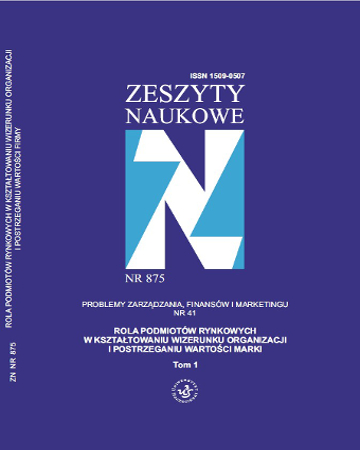
ISSN: 1509-0507
eISSN: 2353-2874
OAI
DOI: 10.18276/pzfm.2015.41/1-12



Issue archive /
ZN 875 PZFiM nr 41 t. 1
Implementing the Consumer-Based Brand Equity Scale for Beer Brands – A Tyskie and Żywiec Case Study
| Authors: |
Przemysław
Łukasik
Uniwersytet Marii Curie-Skłodowskiej w Lublinie Bruno Schivinski Politechnika Gdańska |
| Keywords: | consumer-based brand equity beer brands brand awareness |
| Data publikacji całości: | 2015 |
| Page range: | 10 (155-164) |
Abstract
The concept and management of brand equity is of great importance to scholars and managers. In this article, brand equity is approached from the consumers’ point of view i.e., consumer-based brand equity (CBBE) in the context of two beer brands offered in Poland – Tyskie and Żywiec. The objective of this article is to demonstrate how managers can implement the CBBE scale as an audit and monitoring instrument to their brands. A sample of 311 respondents was analyzed to generate scores for brand awareness, brand associations, perceived quality, and brand loyalty. Additionally, scores for overall brand equity were also generate. The results demonstrated that the scores of brand awareness for Żywiec was higher than Tyskie, however, Tyskie scored higher for brand associations, perceived quality, and brand loyalty. The brand Tyskie also achieved better overall brand equity scores than Żywiec.
Download file
Article file
Bibliography
| 1. | Aaker D.A., Managing brand equity: Capitalizing on the value of a brand name, The Free Press, New York 1991. |
| 2. | Buil I. et al., A cross-national validation of the consumer-based brand equity scale, “Journal of Product & Brand Management” 2008, No. 17 (6). |
| 3. | Chin W. et al., A partial least squares latent variable modeling approach for measuring interaction effects: results from a Monte Carlo simulation study and voice mail emotion/adoption, “Information Systems Research” 2003, No. 14 (2). |
| 4. | Christodoulides G., de Chernatony L., Consumer-based brand equity conceptualisation and measurement: A literature review, “International Journal of Market Research” 2010, No. 52 (1). |
| 5. | Dębski M., Kreowanie silnej marki, PWE, Warszawa 2009. |
| 6. | Fornell C., Larcker D., Evaluating structural equation models with unobservable variables and measurement error, “Journal of Marketing Research” 1981, No. 18 (1). |
| 7. | Hair Jr. J.F. et al., Multivariate data analysis, Pearson Education Limited, Harlow 2014. |
| 8. | Kall J., Kłeczek R., Sagan A., Zarządzanie marką, Oficyna a Wolters Kluwer business, Kraków 2006. |
| 9. | Keller K.L., Conceptualizing, measuring, and managing customer-based brand equity, “Journal of Marketing” 1993, No. 57 (January). |
| 10. | Keller K.L., Lehmann D.R., Brands and branding: Research findings and future priorities, “Marketing Science” 2006, No. 25 (6). |
| 11. | Mącik R., Korba M., Wiarygodność pomiaru w badaniach mixed-mode: Porównanie efektów stosowania PAPI i CAWI, Prace Naukowe Uniwersytetu Ekonomicznego we Wrocławiu No. 96, Wrocław 2010. |
| 12. | Pappu R. et al., Consumer-based brand equity: Improving the measurement – empirical evidence, “Journal of Product & Brand Management” 2005, No. 14 (3). |
| 13. | Schivinski B., Dabrowski D., The consumer-based brand equity inventory: Scale construct and validation, „GUT FME Working Paper Series A. Gdansk (Poland): Gdansk University of Technology, Faculty of Management and Economics” 2014, No. 4 (22). |
| 14. | Schivinski B., Łukasik P., Rozwój badań nad kapitałem marki bazującym na konsumencie – przegląd literatury, “Marketing i Rynek” 2014, No. 11. |
| 15. | Yoo B., Donthu N., Developing and validating a multidimensional consumer-based brand equity scale, “Journal of Business Research” 2001, No. 52 (1). |
| 16. | Zeithaml V. A., Consumer perceptions of price, quality, and value: A means-end model and synthesis of evidence, “Journal of Marketing” 1988, No. 52 (July). |